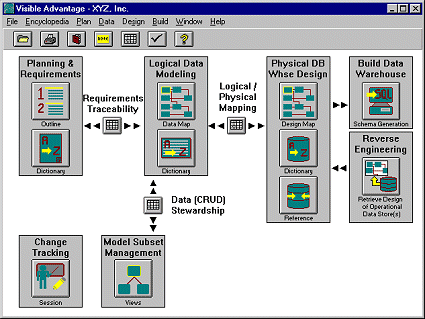 |
Data Warehouse Edition |
Operational data source redundancy mapping, requirements traceability, data warehouse design, transformation process analysis, and data warehouse construction.
The new Data Warehouse edition dramatically accelerates the data warehouse construction life cycle. Visible Advantage Data Warehouse Edition enforces data warehouse principles and techniques by its unique ability to map and trace complex business requirements from inception through Data Warehouse Design and building. The new tool is also uniquely suited to allow the integration of existing Data Marts by tracking the common data in the various data marts to their corresponding elements in the Data Warehouse.
The Visible Advantage Data Warehouse Edition automates all of your data warehouse analysis and design tasks from the original inception (including scope and business benefit) through the creation of the data warehouse database (normalized, denormalized, star and/or snowflake schema).

The Data Warehouse Edition specifically automates the following tasks and deliverables:
- Business requirements, goals, and business driver definition.
- Identification of business data needs and data warehouse dictionary.
- Automated recovery of database designs from potential data sources.
- Cross-reference capability to identify specific multiple sources for any DW attribute.
- Visual analysis of transformation processes to specify source and target fields.
- Data warehouse and Data Mart design.
Product Description
Key Features of Visible Advantage Data Warehouse Edition:
- Business Requirements Capture - Unique ability to define and manage complex business requirements and to trace them to the data warehouse design.
- Corporate Standard Data Definition - Identifies the standard data structure for the data warehouse, allowing them to be cross referenced to reverse engineered operational data source designs, the Corporate Data Warehouse, and to all of the Data Marts in the organization. Data structure can be denormalized for performance differently in any design while keeping traceability links to the corporate data standard.
- Visual Design - Graphical analysis of transformation processes from the operational source to the data warehouse design using our exclusive Data Warehouse Design diagram.
- Seamless Links - To and from: operational datastores, business requirements, logical enterprise architectures, and physical data warehouse or datamart designs. And since they are all integrated, changes in any one design are automatically reflected in all other designs and in cross-phase links.
- Central Data Repository - Allows simultaneous update of any of the objects managed by the toolset by anyone across your organization, eliminating update problems and enabling collaborative design.
- Automated recover of operational data source design - Existing data sources can be scanned via native DBMS connections, ODBC, or via SQL scripts to recover the designs of legacy data sources.
- Redundant Data Identification - Multiple sources are identified so the optimal data source for the warehouse can be determined, increasing data quality.
Your 5 Steps to Data Warehouse Success:
- Define the Business Requirements: The DW edition starts by automating the definition of business requirements, which should be the first step in a data warehouse project.
- Identify Operational Data Sources: The DW Edition can scan your existing databases and reverse engineer models of those diverse systems. Once imported, the structures of the various databases can be analyzed and cross referenced to determine redundant data, and the selection of the optimal data source for the warehouse can be made from the multiple potential sources.
- Analyze and resolve multiple data sources: The Data Warehouse design is modeled at the logical data level and linked to the candidate data sources. The selection of the optimal Operational Data Sources can then be made from the multiple potential sources.
- Design the Data Warehouse: The Data Warehouse can then be identified at the logical data level, then implemented as a fully normalized structure, a denormalized and/or summarized star schema structure, even one or more of each structure. The Data is traced to all of its implementations automatically, allowing you to see all of the implementations of a particular attribute.
- Specify Transformation Processes: Once you have all of the potential sources defined and the data warehouse designed, you can now choose between the multiple sources to design the transformation and integration processes based on the very best data source.
Note: The above order of steps, while typical, are not mandatory. You may do the above steps in the order that makes sense to you and your project team. The Data Warehouse toolset can also help with many common Data Warehousing problems like:
- Integration of Data Marts that have been independently created.
- Impact Analysis for changes to requirements, data needs or database designs.
Once the warehouse is designed and built, delivering quality business data that meets the defined needs is a snap using your choice of Query or DSS tools. Changes, additions, and updates are a breeze. |







